Overview of gooseberry diseases and pests

Cultivated plants often precipitate pests and various diseases, and gooseberries are no exception. In this article, we will provide a description of diseases and parasites common for gooseberries, as well as talk about chemical methods of combating them and effective folk remedies.
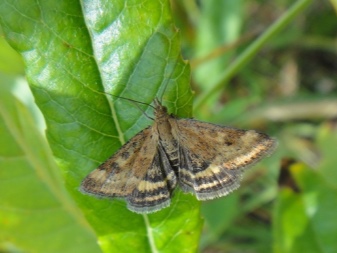
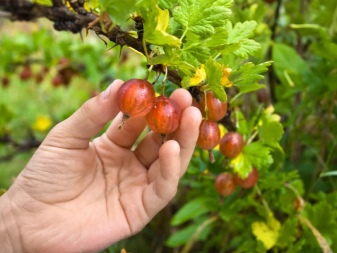
Diseases and their treatment
Powdery mildew
Powdery mildew is a common fungal disease that often affects gooseberries. The disease develops most actively in conditions of high humidity of air masses and a lack of water. It is possible to determine the presence of this disease in a shrub by the following signs: a whitish bloom is formed on the gooseberry berries, resembling a cobweb or mold in appearance. This is exactly what the first stage of a fungal disease looks like - it is necessary to suppress it already here, in the future it will be more difficult to treat the shrub. Further, the disease will progress: the whitish plaque will change to a brown crust, the affected shoots will curl and deform, after which they die, the leaves will turn yellow, curl and break, and the fruits themselves will crack and fall, never ripening. If you ignore the disease, then there is a risk of losing not only a rich harvest, but also the plant itself.
In order to prevent the occurrence of this disease, it is important at the end of the season, in autumn, to get rid of old foliage, fungal spores often hibernate in it, and also to eliminate weeds, which, as a rule, are carriers of the infection. If the plant could not be saved, and it became infected, then in this case it is necessary to fight the disease. For this, it is recommended to resort to the use of specialized drugs. Among them, fungicidal agents are especially distinguished. So, you can spray plants with "Fitosporin" or "Alirin".
However, please note that before using this or that drug, you must carefully read the instructions, which are usually located right on the package.
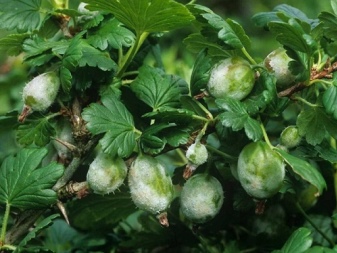
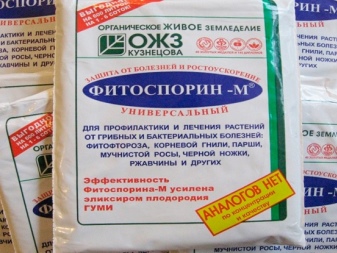
Anthracnose
Another gooseberry disease, which is activated mainly in rainy summers, around the middle of the season. It is characterized by the following symptoms: the leaves begin to become covered with small dark spots with tubercles. Gradually, these spots increase in size and merge with each other. As a result, the diseased foliage begins to dry, after which it falls off. In this case, as a rule, the lower leaves fall off. The disease also affects the yield - it sharply decreases, and the shrub itself almost stops growing and developing.
You can save the gooseberry bush from anthracnose infection. For this, the plant must be sprayed with "Nitrafen" or copper sulfate with a concentration of 1%. Note that this must be done before bud break. In this case, it is necessary to spray not only the plant itself, but also the soil around it. There is another remedy that helps get rid of fungal spores. So, you can pour boiling water over the bushes. This should be done in early spring, before the buds awaken.
Do not be afraid that you will harm the plants: during irrigation, the water temperature will drop to +70. This will kill the fungus, but it will be completely harmless to the plant.
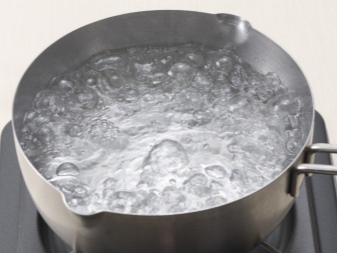
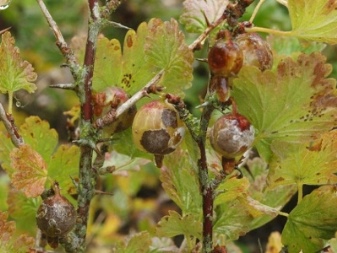
Septoriasis
This is another disease common to currants and gooseberries, as they are related berry bushes. Septoria has the following symptoms: the leaves of the plant begin to become covered with brownish specks, which have a rounded and sometimes angular shape. Over time, such spots become light, but a dark border remains around them. In the future, spots can also form on gooseberry fruits. If the disease is not stopped in time, then the foliage of the bush will begin to fall off.
To prevent the occurrence of this disease, the plant must be treated with Nitrafen or copper sulfate. This should be done in early spring, when the buds have not yet blossomed. If the berry bush is already sick, then in this case the plant must be treated with fungicidal preparations. Colloidal sulfur or a 1% solution of Bordeaux liquid can also help in the fight against septoria.
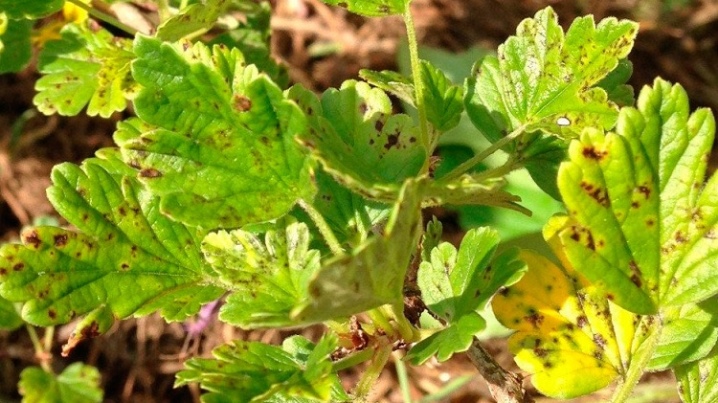
Mosaic
Mosaic is a more insidious viral disease in comparison with the rest, since it cannot be cured. It is not difficult to recognize this disease: the leaves of the gooseberry begin to turn yellow, and the yellow spots that form on the bush remind many of the stains. With the development of the disease, the leaves begin to shrink, wrinkle, and the shrub itself stops growing and developing.
Mosaic shrubs can become infected from harmful insects, in particular, from aphids or ticks. And therefore, the first thing you can do to prevent gooseberry infestation is to regularly eliminate pests on the site, as well as get rid of weeds, which are often their carriers. In addition, in order to prevent the formation of a mosaic, it is recommended to carefully check the seedlings that you purchase for planting: they should not be suspicious or weak. As mentioned above, the disease is not amenable to treatment. Therefore, if it does arise, the shrub must be urgently uprooted and destroyed in order to prevent infection of healthy plants.
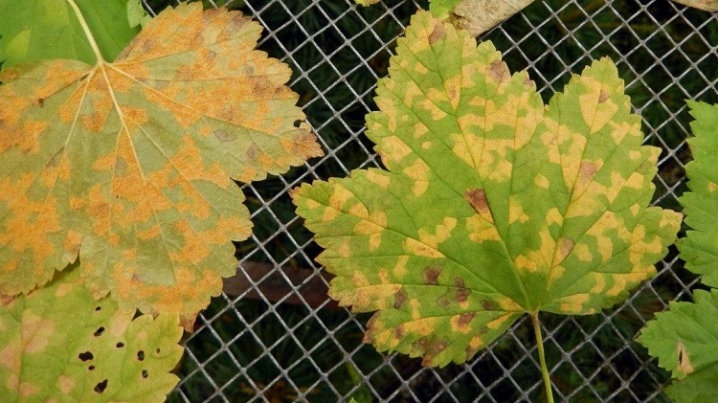
Columnar rust
A disease such as columnar rust is not so common in gooseberries. As a rule, it affects berry bushes only if trees such as cedar or pine grow near the site. This disease has the following series of symptoms: the leaves, flowers and ovaries of the bush are covered with small yellowish specks. On the lower part of the leaves, as a rule, reddish growths appear.
This disease should not be confused with goblet rust - this disease has similar symptoms, but it infects the plant mostly from sedge that grows nearby. Symptoms characteristic of this disease are as follows: reddish pads appear on the gooseberry. It is possible to deal with these two types of rust, the methods for both diseases are the same. So, the shrub must be treated with fungicidal agents.
This must be done several times: the first - before the foliage blooms, the second - when the buds appear, the third - after flowering. If the disease has been started, then it is recommended to carry out the treatment for the fourth time.


Gray rot
Gray rot is a fungal disease that often occurs in gooseberry bushes. The fungus provokes the disease. First of all, the disease attacks the lower branches, which is why the berries begin to rot. Subsequently, the berries begin to fall off. On the leaves of the gooseberry, a slippery coating forms, the tissues of the culture rot. Please note that this fungal disease progresses at a tremendous speed, and therefore it is not worth starting it, otherwise there is a risk of losing not only the crop, but also the bush itself as a whole.
To provide the plant with protection from gray rot and prevent its occurrence, it is necessary to follow the rules of agricultural technology, namely: do not allow thickening of the plantings, otherwise the air circulation will be poor, watering in a timely manner, apply top dressing. It is also recommended to get rid of parasites - from weevils and caterpillars that carry the fungus. If the plant still gets sick, then the diseased parts of it must be eliminated and burned so that the disease does not spread to healthy shrubs, the bush itself will then need to be carefully processed.
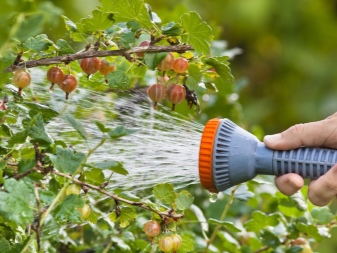
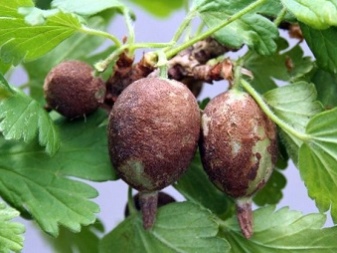
Pests and the fight against them
Pest insects often infect gooseberry bushes. At the same time, they not only eat up the bush, but also often infect it with fungal diseases, which also does not have the best effect on the condition of the plants. So, the most frequent visitor to the gooseberry bush is the fire butterfly. The butterfly is inconspicuous: it has brownish wings that do not differ in external beauty. By themselves, butterflies do not carry any harm, but their caterpillars are very harmful. Caterpillars of the butterfly are variegated, they have a greenish or yellow-green color and a black head. It is because of them that gooseberry leaves are eaten - worms feed on them. You can fight this parasite with the help of homemade ash infusion, as well as chemicals such as, for example, Aktara or Aktellik.
The same methods can be used to combat the larvae of such harmful insects as the sawfly or moth. These parasites also eat gooseberry foliage, infect shoots, and also harm fruits and flowers by actively gnawing their inner parts. You can also use a tobacco-based product against them: for it you need 0.4 kilograms of the main component and 10 liters of water. All this should stand for 48 hours, after which the mixture is diluted again in a bucket of water. It is necessary to process plants with it several times at intervals of a week. Another parasite that is often found on berry bushes is caterpillars... They inflict particular harm on the shoots of the plant, feeding on their core.
In order to prevent the emergence of these parasites, you must first of all deal with the colorful butterflies that reproduce them.
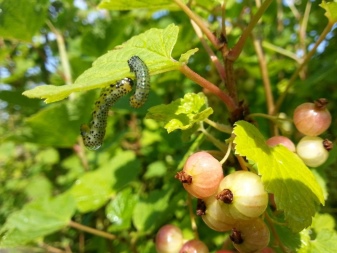
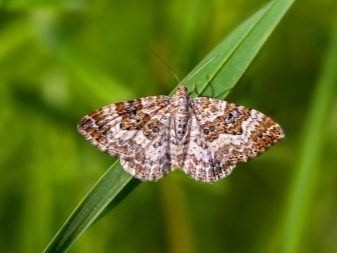
You can get rid of this parasite in the spring, even before flowering. For this it is necessary to eliminate all parts of the plant that were affected, and then spray the plants with a special "Sumition" agent.
Another frequent visitor to the garden where the gooseberry grows is gall midges... This pest lays eggs in young leaves. Subsequently, the hatched larvae begin to very actively infect the leaves, gnawing holes in them. It is recommended to fight these parasites with the help of chemicals.
It often affects gooseberry bushes and ticks. This parasite settles on the bush during the early spring, while for the place of residence it chooses the lower side of the leaf plate, which soon becomes covered with cobwebs. The tick actively feeds on the juices of the bush, which affects its condition: the plant begins to weaken, its leaves begin to turn yellow, and then die off. They fight this pest with inorganic fungicidal agents, as well as with a solution of colloidal sulfur.
It is worth mentioning about a tool that copes well with many of the listed pests. In particular, with those that survive the winter without problems and become more active for the next season. It is suitable both against parasites and against fungi. You can prepare this product yourself, it is prepared on the basis of soda ash: you need to mix 50 grams of the product and 10 liters of water. Then it can be used for processing. Plants can also be treated with this agent for prophylaxis. It can also be used during fruiting, because it is absolutely non-toxic.
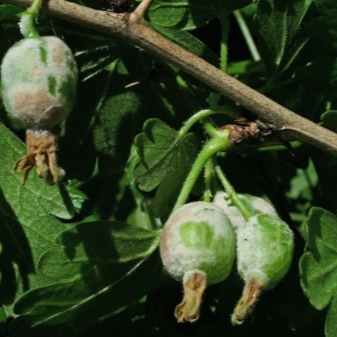

Prevention measures
Preventive measures will help get rid of many problems associated with cultivated plants, or prevent them in time. The very first thing to do – periodically inspect plants for diseases or pests. This must be done especially carefully in June - it is in this month that many parasites begin to awaken, because it becomes warm.
Take good care of your plants. Provide them with timely watering, apply top dressing and fertilizers on time, eliminate weeds. And after harvesting, it is imperative to get rid of old foliage, because parasites and their larvae, as well as fungal spores, often hibernate in it.Periodically arrange for preventive treatment of shrubs. This should be done even if there are no parasites or symptoms of disease.
Do not allow the plantings to thicken, because this interferes with air circulation, which creates conditions favorable for the development of fungi. Here it is worth saying about the plants that are grown in the greenhouse: in order to keep them in good condition, the room must be regularly ventilated.
Do not forget about the disinfection of garden tools. Often it is with its help that spores of harmful fungi are spread.
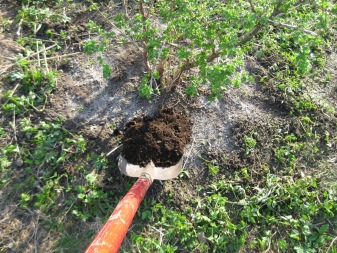
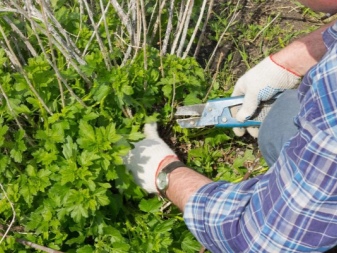





The comment was sent successfully.